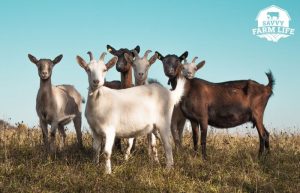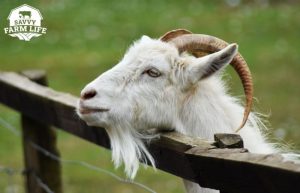
What’s the Average Lifespan of a Goat?
Goats have become a common homesteading choice for many reasons. Goats are smaller and more low maintenance compared to other livestock animals like cows and horses. Goats are also a versatile income source, producing milk, meat, and cashmere. Before you get goats, knowing how long they live can help you plan your herd and prepare for production.
How long do goats usually live? On average, most goat breeds live 8-12 years. Many factors affect lifespan, such as genetics, long-term living conditions, diet, and many others. But as veterinary knowledge and skills increase and more goats are being kept as pets rather than production animals, the life expectancies tend to be longer now than ever before.
Two important factors that will effect your goat’s lifespan is the breed and habitat. Domesticated goats often live longer than wild goats, as wild goats have many more threats and risks. Understanding these things can help you pick the right goats for your herd.
Goat Lifespan By Breed
Some breeds of goats tend to live longer than others. In dog breeds, this is oftentimes due to genetic predispositions to hip problems or organ problems. These health issues arise as a result of inbreeding of related animals to produce offspring with certain traits, such as breed-standard appearances. It is unclear if the same holds true for goat breeds, but it is a possibility.
Read on for the life expectancies of the most commonly available homestead and pet goats in the United States, as well as for more about the other factors besides genetics that affect goat lifespan.
Alpine Goats
While technically classified as a dairy breed, these goats can also be good for meat production. They have a pretty average life expectancy. Expect Alpine goats to live around 8-12 years.
Angora Goats
Primarily kept for their production of valuable mohair fibers, these goats don’t have as much stress on their bodies to produce offspring or gain muscle, which may play a part in extending their lives. Their typical lifespan is around 10 years.
Boer Goats
One of the largest goat breeds in the United States, these meat goats are highly valued for their prolific offspring production, large body size, and docility. They grow quickly and are easy to deal with. They are expected to live around 8-12 years, with some individuals having made it into their twenties.
Kiko Goats
This giant goat breed was developed in New Zealand for thicker musculature than the indigenous goats. They are also hardier and able to weather more challenging living conditions than most goats. Kiko goats tend to live 8-12 years as well.
LaMancha Goats
Sporting uniquely tiny ears, this dairy goat breed originated in Spain and has a life expectancy of 10 years.
Myotonic Goats
Also known as “fainting goats,” these goats have a wide span of life expectancy from 10 -18 years.
Nigerian Dwarf Goats
These West African dwarf goats are primarily used for their dairy production abilities. They live a little longer than the average goat. 15-20 years is their life expectancy.
Nubian Goats
With their arched Roman noses and their basset hound-like ears, this breed maintains an unforgettable look. They are also incredibly vocal, but they do make excellent dairy goats and tend to live 18-20 years.
Oberhasli Goats
These dark-furred dairy goats were imported to the United States from Switzerland in the early 1900’s. These tend to live the average 8-12 years as well.
Pygmy Goats
These tiny goats tend to measure no more than 20 inches tall as adults. 12 years is the typical lifespan of these goats.
Pygora Goats
As their name implies, this breed was created by crossing angora goats with pygmy goats. The result is a small but fluffy goat with good quality wool, which is the main commodity that these goats are bred for. Pygora goats tend to be longer-lived at 15-20 years.
Saanen Goats
Another breed originating from Switzerland, these goats are larger and excellent milk producers. They tend to live the average goat lifespan of 8-12 years.
Spanish Goat
The Spanish goat is a short-lived meat breed with a life expectancy of 6-7 years.
Toggenburg Goats
This diary goat, also from Switzerland, is valued for its dairy production and also has a life expectancy of 8-12 years.
Other Factors That Influence Goat Lifespan
 Just like humans, goats are affected by their surroundings. Extreme temperatures, other weather conditions, and the presence or absence of ideal food sources can affect goats physically. But other less obvious stressors can also be problematic.
Just like humans, goats are affected by their surroundings. Extreme temperatures, other weather conditions, and the presence or absence of ideal food sources can affect goats physically. But other less obvious stressors can also be problematic.
The frequent presence of predators, for example, could cause these prey animals to be constantly distressed even if the predators can’t get to them. The inability to escape the sense of predatory animals in close proximity can cause damaging stress, so it’s important to ensure that your goats don’t feel constantly threatened.
Any time humans keep animals in captivity, there is a good chance that we won’t be able to successfully replicate all of the needs that would naturally be met in the wild. With their food easily accessible and all their needs met, pet goats can actually suffer from extreme boredom, which can result in negative behaviors and potentially shorten their lifespans.
A sign that your goat is stressed is that they won’t sleep. To learn more about a goat’s sleeping patterns, check out my article How Do Goats Sleep? Goat Sleep Behavior Guide.
Heat Stress
While goats are considered one of the hardiest farm animals most capable of thriving in tropical environments, their health can be affected by extreme heat. A study conducted by the University of Melbourne in April of 2021 found that when goats are exposed to temperatures above 100 degrees Fahrenheit, the adaptive processes that their bodies perform to regulate their body temperature had a negative effect on production.
When this survival mechanism kicks in, energy is directed to thermoregulation and away from normal bodily processes. Growth was reduced by 12%, milk production by 3-10%, and meat production by 4%.
Even though those numbers don’t look that significant, that much loss of production does add up over time. And those conditions are uncomfortable for the goats. So it’s important to provide your goats with shaded areas and maybe even fans if you live in an area characterized by more intense heat.
Mental Stimulation
Goats are herd animals with strong social needs. Keeping one solitary goat all alone will likely cause that goat some psychological problems, which can result in erratic/unpleasant behaviors as well as listlessness/loss of will to live. With the need to be a part of a herd ingrained in their DNA, goats do not do well on their own. A lonely goat may be more likely to get into trouble or even danger simply out of boredom. To prevent this problem, give your goat a few friends.
Because goats are also masters of escaping their enclosures with or without friends, extra care should be taken not only to secure their space, but also to keep them mentally engaged and content with the space they have. One great way to do this is to give them safe things to climb on. Climbing is a natural behavior that goats enjoy engaging in, and providing them with a safe set of items to climb up on will help them be less interested in climbing on things they shouldn’t.
Another mental stimulator for goats is foraging toys. The point of foraging toys is to encourage natural foraging behavior and keep your goats occupied. Making food more challenging to get to is a great way to increase their mental stimulation. You can buy foraging toys at pet stores and online, but there are also easy and inexpensive DIY options.
For example, if a few small holes are drilled into a piece of pipe and then some food is added to the pipe and the pipe is capped on both ends, the goats have a food dispenser that they can get food from only if they toss and roll the pipe around.
You can also freeze goat-safe treats in ice cubes or ice chunks and disperse those throughout the pasture for them to find. Hiding fruit bits inside vegetables or piles of greens or hay is another option. Hanging hay and other treats from a tree branch is also good if you can find a way to prevent them from getting ahold of and swallowing any string.
Living the Pet Life
Obesity is a growing problem in companion animals, especially those that live in the house with us. If you keep pet goats and tend to be extra generous with treats, you may see health signs associated with overeating in your goats. Arthritis and heart health problems are only a couple of the issues that can result from obesity in goats.
Feeding your goats a balanced, species-specific diet with only occasional treats is the best way you can care for them nutritionally and extend their life while maintaining a high quality of life as much as possible. Check out our Complete List of What Goats Can (and Can’t) Eat for more information about a healthy goat diet.
